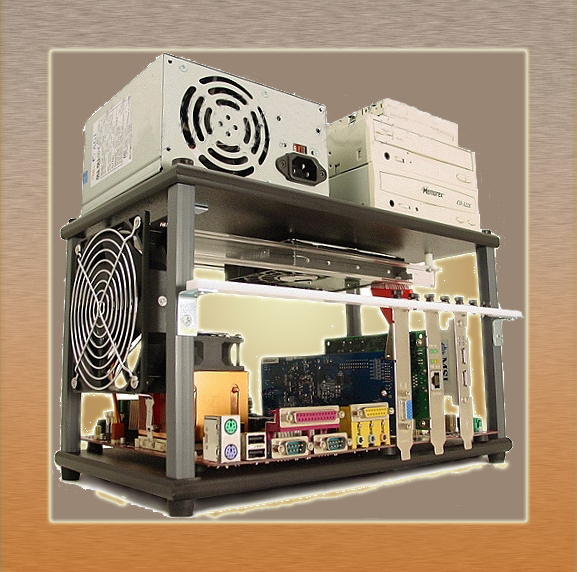A Case in Point.
In the past, when digesting reviews for the latest hardware or conversing with a legion of customer service reps, usually mere moments before receiving an RMA number, I’d become aware for the phrase “open bench”. The term refers to a condition under which certain components are tested, either for the purpose of extracting additional performance or to replicate and diagnose defects. The procedure always incurred my displeasure, for whenever I returned a faulty product, its operational shortfalls were invariably symptomatic of excessive heat, an ailment greatly alleviated by excluding what I considered an essential ingredient for a functional and practical system.
Of course you can overclock it to the stratosphere. No doubt you can’t observe the intrusive artefacts and errant distortions I complain of, Yes, I’m sure you left it running for 12 hours without a single lock-up. Perhaps that’s because you’ve installed it on a table next to an open window and an exceptionally powerful north wind, who in the name of sanity would make a routine out of that?! Somebody who enjoys losing their credit card in a mountain of exposed circuitry, those who take pride in an office that looks like robot squatter’s hovel, a twisted masochist who garners pleasure by repeatedly snagging their limbs on swaths of razor sharp solder joints?
Who would have guessed that a life-changing compromise would evolve from such rhetorical bitterness, until a casual spate of armchair window shopping lead me to this… sub-section entitled “test chassis” on the website of a reputable e-tailer from which I’d ordered several times in years gone by.

This was the sole item listed, but it was perfect. With it I’d be absolved of all my heat crimes. I could become a leading activist for the welfare of hot-housed micro-chips and preserve the precious time I’d hitherto squandered whist squinting for lost screws, routing connectors through ill-appointed holes lined with flimsy rubber grommets intended to shield wires and fingers from sharp edges which popped our every time you dared touch them with a wire of finger, wrestling with yet another “patented” mounting mechanism that was about as intuitive as a flat pack nuclear reactor.
Scrabbling frantically for my flexible monitory go-between, whose surface bore a tangle of scars inflicted by pennies, pounds and pen knives and had somehow survived half a dozen rinse and spins, I hastily shuttled my cursor over to where an”add to basket” applet should have nestled, only to discover a small and symbolic red square adjacent to the familiar and intolerably tiresome phrase out of stock” discontinued”. No matter, to a fastidious tinkerer, the prospect of uninhibited accessibility at almost no cost to structural procession was worth a voyage across the seven seas, never mind seven minutes of diligent Googling.
With my hobbyist’s antennae bristling in anticipation, I was soon frequenting the manufacturer’s website, whose homepage proudly advertised several notably enhanced reworks of the product that had arrested my attention including, to my enraptured delight, an HTPX variant for my beloved EVGA SR-X. The Top Deck Tech Station, I mused shortly after a chorus of financially binding clicks, would be my passport to open plan paradise.
One week and a sizeable wack of import duty later, I had taken tentative delivery of the. Tentative because to lessen the risk of shipping induced scars and avoid yet further expenditure, I had purchased the kit in its disassembled state and thus, might well be obliged to assimilate instructions translated by a potted language student referencing a multitude of screws, bolts and pegs, all of which looked identical and worse still, decipher diagrams more dense and complex than the blueprint for a portable bio research facility. I need not have fretted.
The instructions were flawlessly conveyed, featured photographs to illustrate each stage of the construction process and even included a friendly preface informing the user of how orientation references should be interpreted in as well as the tools required and approximate assembly time. In hindsight, the latter was the only advice with which I’d quibble, since it did not account for a builder who had, fortuitously, elected to take over one hundred and twenty photographs chronicling his chronic clumsiness and whose sense of direction rivalled that of a whirling dervish on a merry go round.
The aforementioned fact also explains why, when browsing this gargantuan gallery, an observant reader will note that a few cursory shots before its conclusion, the PCI card brace magically changes positions, initially having been installed on the wrong side of the connected vertical supports and therefor, misaligned with the motherboard’s expansion slots!
To compound my incompetence I had secured the motherboard to the upper deck and was attempting furiously to fit a pair of Nvidia’s flagship “polygonists” before noticing this pathetic mistake.




